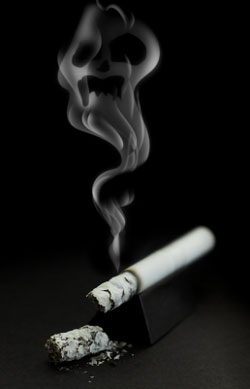Fire Extinguisher : 101
Fire Safe Cigarettes Save Lives
| Home |
| About Fire Extinguishers |
| Using a Fire Extinguisher |
| Fire Prevention |
| Fire Hazards |
| First Aid for Fire |
| Financial Protection |
| Biggest Fires in History |
| Firefighters |
This site was voted:

by onlinefiresciencedegree.org
(scroll to 74 on the list)
This article is intended to provide individuals with general information pertaining to how fire safe cigarettes save lives. |
There are approximately 700 to 900 deaths per year in the U.S. resulting from fires ignited by unattended cigarettes. New technology has given us a fire safe cigarette; a way to reduce their capacity to burn when not being actively smoked. Cigarette manufacturers are now wrapping cigarettes with two to three thin bands of less porous paper that act as “speed bumps.” If a lit cigarette is left unattended, it will self-extinguish when the burning reaches one of these bands. Fire safe cigarettes are now mandatory in all of Canada, and in the U.S. states of New York, Vermont, Illinois, Massachusetts, New Hampshire, Oregon and California. Seventeen more American states will adopt the law in 2008 and 2009.
 History
of fire safe cigarettes
History
of fire safe cigarettes
- A 1929 house fire started by a cigarette in Lowell, Massachusetts prompted a U.S. Congresswoman by the name of Edith Nourse Rogers to ask the National Bureau of Standards to develop a “self-snubbing” cigarette.
- In late March of 1932, The Boston Herald covered a story noting that a “self-snubbing” cigarette had been produced by the Bureau, and it urged cigarette manufacturers to adopt the idea. However, not one cigarette company implemented the project.
- In 1974, Senator Phil Hart introduced a Bill to the U.S. Senate requiring “self-extinguishing” cigarettes. It was approved by the Senate, but was then defeated by the tobacco lobby in the U.S. House of Representatives.
- It was not until 1979, when five children and their parents died tragically in a cigarette-ignited fire in Westwood, MA, that the issue of fire safe cigarettes made some headway. Congressman Joe Moakley was prompted to introduce a fire safe cigarette Bill in the U.S. House of Representatives.
- In 1980, Moakley was joined by Senator Alan Cranston and then Senator John Heinz in 1984 to present the Bill to the U.S. Senate.
Current efforts
After being introduced into the Senate in the mid-80’s, the fire
safe cigarettes Bill went through extensive testing and research methods
overseen by the Technical Study Group (under President Reagan).
In 1990, President Bush signed Moakley’s Fire Safe Cigarette Act and funded another three-year research effort to come up with an effective “test method” that would establish fire safety performance standards for cigarettes.
In 1993, The Technical Advisory Group overseeing the program reported that the “test method” had been developed. Moakley’s last introduction of the Fire Safe Cigarette Bill was in 1999. It required the institution of a cigarette fire safety standard and would oblige the Consumer Product Safety Department to employ the standards within 18 months. However, the Bill was stalled in Congress. Moakley died shortly thereafter and the cause was taken up by Senators Durbin and Brownback, and Congressmen Markey and King.
New York
Adopts the Test Method
Victory finally came in 2000 when New York became the first state to adopt
the “test method” and the law went into effect in the year
2004. Fire safe cigarette legislation is now being introduced in several
other states and countries.
Does it work?
- Fires started by unattended lit cigarettes are the number 1 cause of fire-related deaths in the U.S.
- In 2003, there were approximately 2600 cigarette-related fires. In 2005, that number had decreased by 22%, a significant drop.
- A Harvard-led research study in 2005 found that regular cigarettes will burn to the end 99% of the time, while fire safe cigarettes will burn to the end only 10% of the time.
- They also found that there was no significant taste difference between the two types, no substantial difference in toxicity levels, no increase in the cost of a pack of cigarettes, and the percentage of cigarette sales stayed the same.
Written by
John Manley
Having experienced 2 house fires, John Manley now devotes some
of his spare time educating people about the importance of having fire
extinguishers, CO and fire alarms, and proper escape plans though the
website: Fire Extinguisher:
101 - www.fire-extinguisher101.com.